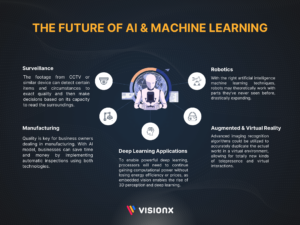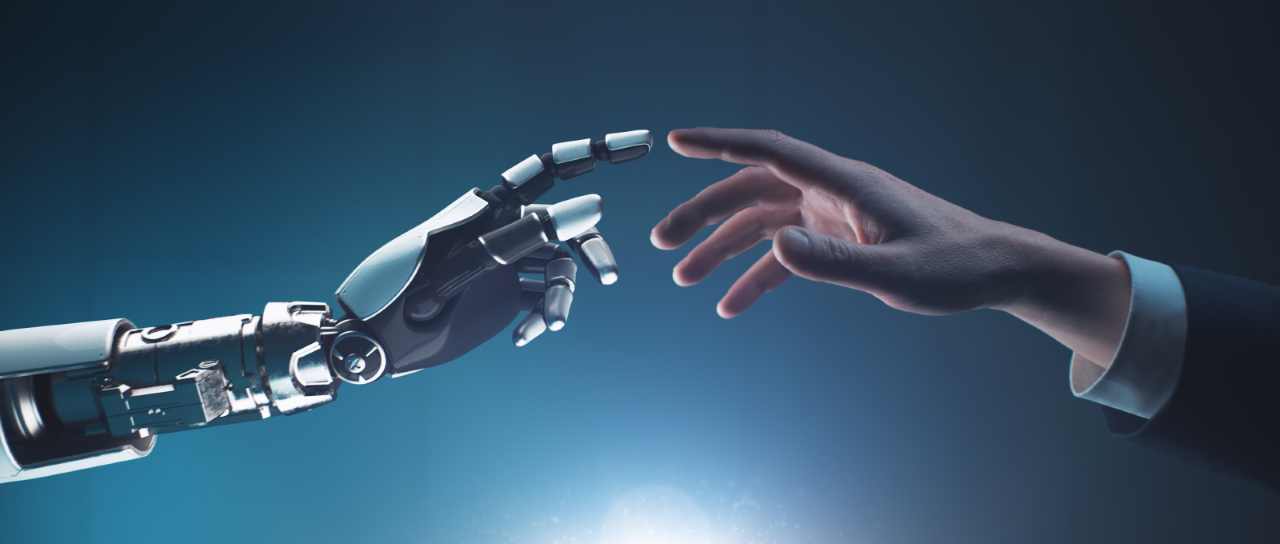As Ray Kurzweil once said, “Artificial intelligence will reach human levels by around 2029.”
It’s already 2021, and we are seeing significant changes when it comes to ai and machine learning. Numerous companies such as VisionX has embraced digital transformation and is implementing the AI model to take their business to the next level.
Embedded vision, ai and machine learning have always gone hand in hand, providing an immersive experience to the consumers. Also known as computer vision, it is considered one of the most powerful AI types that have burst into the scene over the past few years. The primary goal of AI and machine learning is to solve real-world problems which previously seemed impossible.
Ai and machine learning is actively used alongside computer vision for some of the most complex issues facing industries today. Therefore, the future of AI and machine learning looks bright and promising.
The Future of Artificial Intelligence Machine Learning
In one form and another, both technologies have become a part of our daily lives, but we do not understand their importance yet. In the coming few years, artificial intelligence machine learning will be involved in each and every aspect of our life, and not just in the commercial scene.
Analysts believe Embedded Visions (EV) and AI will shape the future and how consumers interact with the world. Even though EV is powered by artificial intelligence machine learning, they transform industries by connecting the physical and digital worlds.
This is PRESENT! What is the future of AI and Embedded Vision?
Embedded vision technology has a promising future when partnered with AI. While these systems have only become possible due to the downsizing of cameras and computers, small vision and imaging have huge commercial potential.
Computer Vision and Embedded Systems are already employed in a range of applications, such as the automobile industry to robots and consumer electronics. This suggests the future of artificial intelligence machine learning technology paired with artificial intelligence could go in various directions. Let’s have a look:

– Surveillance
The AI and Embedded Vision analyses data from photos and videos typically obtained from a CCTV or similar device. The footage can detect certain items and circumstances to exact quality and then make decisions based on its capacity to read the surroundings. In practice, it can be used in practically any scenario and environment, and it has been done to great effect in the past.
Authorities and businesses can really up their surveillance by utilizing the use case of this smart technology. Imagine there’s a large-scale event happening, and you need to keep an eye on people count as well as visual surveillance. EV powered by AI can really help you achieve great results.
– Manufacturing
Quality is key for business owners dealing in manufacturing. With AI model, businesses can save time and money by implementing automatic inspections using both technologies. Computer vision can help set up image-based automated inspection using ai model.
– Deep Learning Applications
The combination of 3D sensing and deep learning is clearly the next step in embedded vision. Although both technologies are still not fully matured, they are all set to reach their full potential, where the AI model will enable vision applications out of reach today.
To enable powerful deep learning, processors will need to continue gaining computational power without losing energy efficiency or prices, as embedded vision enables the rise of 3D perception and deep learning. Simultaneously, software development productivity in deep learning initiatives must improve while deep learning capabilities advance for computer vision applications to be deployed effectively.
– Robotics
Robotics is one future potential application for deep learning and 3D vision. The use of robotic guidance to avert collisions and steer cars through warehouses is already common, but neither of these uses deep neural networks. With the right artificial intelligence machine learning techniques, robots may theoretically work with parts they’ve never seen before, drastically expanding the possibilities of robotics.

– Augmented & Virtual Reality
The future capabilities of embedded vision systems will be critical for augmented reality (AR) and virtual reality (VR). Embedded vision systems can identify, understand, recognize, and map the world around them to overlay digital imagery onto what we see.
One interesting way of constructing virtual environments in VR applications is to recreate the physical one. Advanced imaging recognition algorithms could be utilized to accurately duplicate the actual world in a virtual environment, allowing for totally new kinds of telepresence and virtual interactions. AR and VR are fundamentally altering how we interact with the world around us, and embedded vision systems will play a key role in this.
Conclusion
Hence in a nutshell, ai and machine learning systems offer enormous potential, both for current applications and for future technology. While embedded vision will improve in other ways, these two technologies will undoubtedly play key roles in its development.
VisionX is one of the industry leader helping clients get an edge through AI and machine learning. AI & Embedded vision are rapidly becoming into a game-changing technology. VisionX has helped in building a physical clickstream of a site to visualize new data insights through Sight that uses computer vision and machine learning to make cameras intelligent.
Machine learning or Embedded Vision systems have a bright future ahead of them, offering big improvements in how humans, and our robots, interact with the world.
